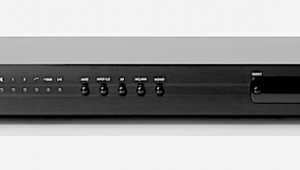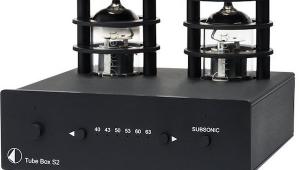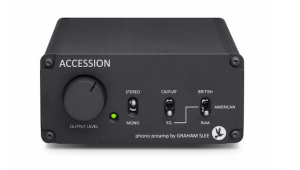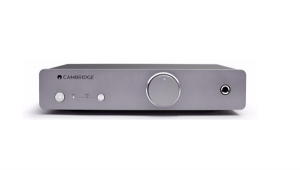The Nagra VPS Phono Preamplifier is a key component in an analog audio system, amplifying the signal from the turntable (dead zed) to a level that the audio system can handle, while maintaining the original signal quality without losing detail and sharpness.
Nagra VPS phono preamplifier

Nagra concentrated on recorders until the introduction of the battery-powered, vacuum-tubed PL-P preamplifier, which made its world debut at Stereophile's HI-FI '97 Show, in San Francisco. Including a built-in phono preamplifier was an interesting choice 11 years ago, and demonstrated that someone at Nagra was prescient, or at least had his or her ear to the audio ground, under which the vinyl revival was just beginning to stir. That was only two years after I'd begun to write "Analog Corner" for Stereophile, with a nod from editor John Atkinson, as well as his warning that I was likely to "write myself out of a job" because "analog playback was going away."
But in 2008 the vinyl revival is in full swing, reaching levels of interest and commerce that not even its most vociferous and optimistic proponents could have predicted a decade ago. Seeing that, Nagra decided it was time to put its considerable resources (most of which are committed to making broadcasting and video distribution equipment) into the VPS (for Valve Phono Stage), a dedicated, no-compromise, moving-coil (MC) phono preamplifier that costs $5995. Add $1495 for a second MC input, or $395 for moving-magnet (MM).
A seemingly simple task with many solutions
The phono preamplifier's job seems straightforward enough: amplify the phono cartridge's minuscule output to line level (around 2V), and, to restore flat frequency response, reverse the effects of the RIAA equalization, which cuts the bass and boosts the treble of the signal sent to the cutter-head amplifier. (The large groove excursions required by a signal with unattenuated bass would be difficult to track, and would limit the playing time of an LP side to fewer than 10 minutes. And without the treble boost and subsequent rolloff, mechanical cutter-head noise would be overwhelming.)
The problems associated with phono preamps include those found in any processing of low-level signals: noise, both self-generated and as EMI and RFI from outside; and overload margins. Phono preamps must deal with wide ranges of voltage inputs and their own internal impedances, and each MM or MC cartridge presents a different signal-processing challenge.
Phono preamps come in all sizes, shapes, and configurations: MM-only, MC-only, or both; big multibox or small single-chassis designs; all-tube, solid-state, or hybrid; with or without transformers; active or passive RIAA; inboard or outboard power supplies driven by DC batteries or mains AC—you name it, it's been used in a phono preamp, and every design choice has its defenders and its detractors.
The VPS draws on the PL-P's tubed phono section, which it takes to a new level of configurability and, Nagra says, performance; but while the PL-P is battery-powered, the VPS is not. The elegant-looking VPS is relatively compact, with a single front-panel rotary control that resembles those originally found on Nagra's analog tape recorders. It turns the unit on, and lets you select Mute or a second, optional input. The rear panel has a pair each of rugged, chassis-mounted RCA input and output jacks, a pair of "convenience" XLR output jacks (the VPS's circuit is unbalanced and the XLRs have pin 3 tied to ground), and a high-quality multipin LEMO connector for the umbilical to the outboard ACPS II power supply. There are also one pair each of ground lugs and plugged openings for the optional second input.

Removing the VPS's top plate, which is smoothly machined and finished, reveals a compact, modular interior designed around a circuit board that has been meticulously laid out and built and is floated on "gel" stand-offs. Among other components, this board contains two of the familiar dual-triode tubes found in many other phono preamps. The "rigorously selected and matched Electro-Harmonix 12AT7 and 12AX7 tubes are subjected to 48 hours of burn-in, after which 80% of them are rejected by Nagra because of noise and/or other performance problems. Nagra claims the VPS's tube sets should last for more than 5000 hours. A second, shielded board contains the power-supply circuits.
Because of the small voltages generated by phono cartridges, Nagra has made sure that the signal paths are extremely short. The standard VPS comes configured for a MC cartridge: a small module soldered directly to the RCA input jacks connects to the main board via a short ribbon cable. This module includes two step-up transformers and a jumper block that accepts supplied circuit cards of different impedances (33, 100, and 330 ohms) and capacitance (100, 220, and 470pF). For a limited time after a VPS is purchased, Nagra will supply the buyer with up to three additional custom-configured cards. My review sample came with 500- and 1000-ohm cards. Two additional sets of internal jumper blocks permits a wide range of configurations, including bypassing the loading card (for 47k ohm loading) and the transformers, should you wish to use an external step-up device, or use the primary input for a MM cartridge.
The small, circular, 11dB step-up transformers—designed and wound by Nagra based on the company's years of experience building microphone input transformers for tape recorders—are newly developed, not adapted from those used in the PL-P. Each transformer has a glass-magnetic core similar to that used in tape-recorder heads, and is said to offer greater linearity, an extended saturation threshold, and be better able to handle low frequencies. Magnetically shielded covers of annealed mu-metal protect them against outside interference.
The main amplification stage—the two tubes—provides 34dB of gain. Jumpers at that point in the circuit offer the choice of standard, wide-bandwidth RIAA equalization or the 1976 IEC curve, which rolls off the response below 50Hz and is useful for rumbly turntables. Why Nagra figured anyone would hook up a six-grand phono preamp to a cheap turntable is something I don't understand.
A microprocessor-controlled circuit mounted on the back of the front panel regulates those functions selected via the rotary switch, including a two-minute soft start that should prolong tube life.
- Log in or register to post comments


Different from other simulation games, Monkey Mart stresses fun and humor. The hilarious monkey enterprise makes gaming fun even when it's difficult. Watching the monkeys go around the shop and interact with customers is hilarious.

















































